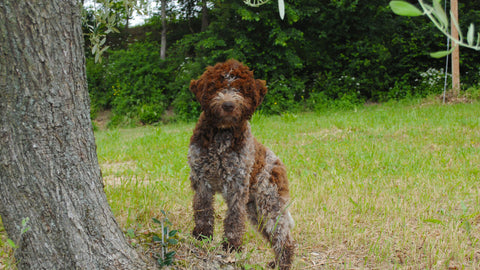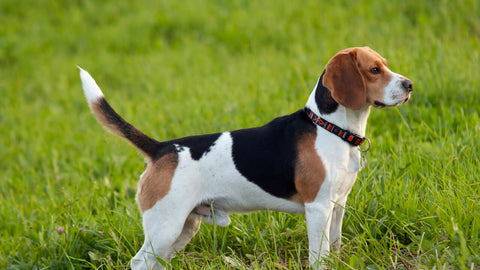Contents
- Introduction to the Pomeranian
- Appearance of the Pomeranian
- Coat and colours of the Pomeranian
- How big can a Pomeranian get
- The character of the Pomeranian
- Training the Pomeranian
- For whom is the Pomeranian suitable
- Is the Pomeranian a family dog
- Care of the Pomeranian
- Nutrition of the Pomeranian
- How much does a Pomeranian shed
- How old does a Pomeranian get
- Typical diseases of the Pomeranian
- How much does a Pomeranian puppy cost
- What to look out for when buying a Pomeranian
- Pomeranian profile
Introduction to the Pomeranian
The Pomeranian, also known as the Miniature Spitz, is one of the smallest dog breeds in the world. Originally from the Pomerania region, this breed has become very popular worldwide due to its charming appearance and lively character. Despite its small size, the Pomeranian has a confident demeanour and radiates a lot of energy and joie de vivre. Its popularity was further enhanced by historical figures such as Queen Victoria, who loved and bred this dog.
Appearance of the Pomeranian
The Pomeranian is a compact, small dog with a striking, fox-like facial expression. Its ears are small, erect and close together. The eyes are almond-shaped, dark and radiate intelligence and alertness. The tail is set high and curls elegantly over the back. However, the most striking feature of the Pomeranian is its thick fur, which makes it appear larger than it actually is.
Coat and colours of the Pomeranian
The Pomeranian's coat consists of a dense, soft undercoat and a longer, more protruding top coat. This double coat gives it its characteristic plush appearance. The Pomeranian comes in a variety of colours, including orange, black, white, cream, blue, brown and even piebald or with patterns like merle. This wide range of colours makes it particularly attractive for lovers of dogs with a wide variety of colours.
How big can a Pomeranian get?
The Pomeranian is one of the smallest dogs. It reaches a shoulder height of about 18 to 22 cm and usually weighs between 1.8 and 3.5 kg. Despite its small size, it has a strong build and a compact, well-proportioned stature.
The character of the Pomeranian
The Pomeranian is a lively, intelligent and alert dog. They are very affectionate towards their owners and often display an amazing sense of self-confidence. Their curious and brave nature can sometimes make them intrepid around strangers or larger dogs. They love to be the centre of attention and entertain their owners with their charm and playfulness.
Training the Pomeranian
Training a Pomeranian requires patience and consistency. Despite their small size, they tend to want to do things their own way. Positive reinforcement and clear rules are important to avoid unwanted behaviour such as excessive barking or stubbornness. They are very intelligent and learn quickly, but you should be careful not to spoil them, otherwise they can quickly become a ‘mini-bully’.
Who is the Pomeranian suitable for?
The Pomeranian is an ideal companion for individuals or couples looking for an active, intelligent and loving dog. It is particularly suitable for people who live in flats, as it does not require much space. Due to its small size, it is less suitable for families with very young children, as they could easily hurt themselves.
Is the Pomeranian a good family dog?
The Pomeranian can be a good family dog if socialised and trained properly. They usually get along well with older children who know how to treat a small dog respectfully. Caution should be exercised with younger children, as the Pomeranian, despite their lively and playful nature, can be sensitive to rough treatment.
Grooming the Pomeranian
Grooming your Pomeranian involves regular brushing to prevent tangles and knots in their fur. They should be brushed daily during their moulting season. Their ears and eyes should also be checked and cleaned regularly to prevent infections. Regular trimming of claws and dental care are also essential, as small dog breeds are more prone to dental problems.
Nutrition of the Pomeranian
A balanced diet is essential for the Pomeranian to promote good health. High-quality dog food that is rich in protein and nutrients is ideal for this breed. It is important to avoid obesity at all costs, as this can lead to health problems. It is advisable to regularly monitor the amount and quality of food and to consult a vet if you are unsure.
How much do Pomeranians shed hair?
Pomeranians shed hair moderately to heavily, especially during their seasonal coat changes in spring and autumn. Regular brushing helps to reduce the amount of hair in the home while also promoting a healthy coat. A well-groomed Pomeranian sheds less hair and has a shiny, healthy coat.
How old does a Pomeranian become?
A well-cared Pomeranian can reach an age of 12 to 16 years, some even older. A healthy diet, regular exercise and preventive veterinary check-ups contribute significantly to the lifespan and quality of life of this little dog.
Typical diseases of the Pomeranian
Pomeranians are prone to a few health issues, including patella luxation (a kneecap displacement), dental problems, tracheal collapse (a weakening of the windpipe), and heart problems. Eye disorders such as cataracts are also common in this breed. Regular health check-ups and observing behavioural changes are important to catch health issues early.
How much does a Pomeranian puppy cost?
The cost of a Pomeranian puppy varies depending on the breeder, origin, parentage and breed standards. On average, the price is between CHF 1500.00 and CHF 3000.00. Puppies with particularly good parentage or rare colouring can also be more expensive. It is important to choose a reputable breeder in order to get a healthy puppy.
What to look out for when buying a Pomeranian.
When buying a Pomeranian, you should pay attention to the health of the parents, the breeding conditions and the seriousness of the breeder. The puppy should be well socialised, vaccinated and dewormed. A responsible breeder will provide all the necessary health certificates and be open to questions about the care and upbringing of the puppy. You should also take a look at the environment in which the puppies grow up to ensure that they are being raised in good conditions.
Pomeranian profile
Height: 18-22 cm
Weight: 1.8-3.5 kg
Coat: Double-layered, dense, long top coat
Colours: Diverse ( including orange, black, white, cream, blue, brown, merle)
Character: Lively, intelligent, alert, affectionate
Life expectancy: 12-16 years
Grooming requirements: High (regular brushing necessary)
Origin: Pomerania (today's Germany/Poland)
Special features: Suitable for apartment living, needs consistent training, is prone to typical health problems of small dog breeds.




Comments (0)
There are no comments for this article. Be the first one to leave a message!